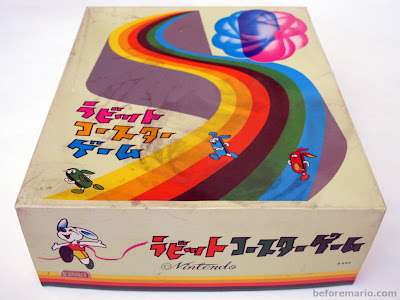Around the same time, more coaster games were released by Nintendo: a second Rabbit Coaster Game (ラビット コースター ゲーム) and the New Coaster Game (ニュー コースター ゲーム).
We have added "#2" to the name of this Rabbit Coaster Game, to distinguish it from the other toy with the same name. However, it is possible that this one is actually the oldest of the two, as the exact release dates or release order of these games is not known.
 |
| Rabbit Coaster Game (#2) and New Coaster Game |
Rabbit Coaster Game (#2) was the simplest of all coaster games, as well as the cheapest; it retailed for ¥500.
The box art features a very colorful artistic rendition of the track the "magic beans" will race on, as well as - appropriately - a number of running bunnies. The blue and pink drawing at the top shows one of the beans in a tumbling motion.
The beans pictured on the top of the box even have funny bunny faces.
 |
| Rabbit Coaster Game (#2) |
The game consist of a single fixed sloping track, with four curves. The sign in the middle of the track says "Rabbit Coaster". A small box holding around 10 beans completes the set.
 |
| Close-up of one of the magic tumbling beans |
If it wasn't for the beans' funny movement, this would be quite a boring race. However, a lead ball placed inside the beans slides back and forth as it rolls down, giving it an unexpected tumbling movement, which results in an unpredictable, exciting race. The lead ball also slows down the bean, prolonging the duration of the race.
 |
| And.. they are off! |
Here we see the beans racing down the track, after they have been released at the top. The curves in the track are positioned in such a way to provide a fair race; all beans have to traverse the same distance to the finish.
 |
| We have a winner: the red bean |
The red bean made it in first!
A Nintendo logo is embossed on the base of the toy, next to the finish line.
Although this Rabbit Coaster Game is fun, the track is a bit on the short side. The New Coaster Game improved on this, and even added some new twists to the concept.
As with some of the other Nintendo toys from around this time, the box shows the game title in Japanese as well as in English. This was probably done to give it a modern trendy feel for the home market, rather than to make it appropriate for use abroad. Note the Nintendo logo in yet another style.
 |
| New Coaster Game |
The bottom part of the game is a base with a fixed sloping track, much like the Rabbit Coaster Game (#2). Mounted on top of this, is a second track piece.
The innovative idea of this game is the way the two tracks are used by different racing objects. This is also why the game comes with two small boxes rather than one: one with the familiar tumbling beans used by all coaster games, the other one holds a little bag with silver ball bearings.
The use of these ball bearings is unique to the New Coaster Game. They will perform the first part of the race. At the start, they are placed side by side at the top of the track.
As soon as they are released, they race down. Because of the weight of the metal balls, they develop quite a speed.
After going through two curves in the top part of the track, the metal balls drop one level down. As they fall, they move one of the red levers each, releasing one of the awaiting magic beans. This is the handover moment of this relay race.
 |
| A small chime can be seen inside the base of the track |
After they have released the lever, the metal balls drop on top of a chime and come to a stop at the back of the game, where their journey ends as unsung heroes.
Meanwhile at the front, the magic beans have taken over for the second part of the race. They tumble down the track, going also through two curves to ensure they all traverse the same length of track.
In the final stretch, the beans pass through a small tunnel and come to a stop at the finish line. An embossed Nintendo logo can be seen to the right of this.
Because of the way they move, the beans take a lot longer for their part of the race, compared to the metal balls. This gives a nice switch of pace to the game; first fast, then slow, with a ringing chime in the middle.























